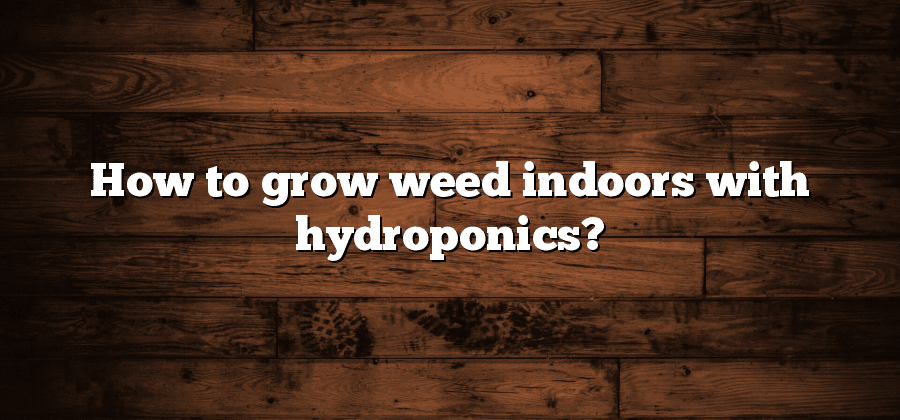Selecting the Right Strain
When it comes to selecting the right strain for your hydroponic garden, there are a few factors to consider. First and foremost, determine the purpose of your cultivation. Are you looking to grow medicinal cannabis for personal use or for commercial purposes? Understanding the end goal will help you narrow down your options and select a strain that meets your specific requirements.
Secondly, take into account the growing conditions and space availability in your hydroponic setup. Some strains may require more vertical space, while others may thrive in limited area. Consider the overall size and structure of the plants, as well as their growth rates, to ensure they can be accommodated in your growing environment. Additionally, be mindful of any specific climate requirements or environmental preferences certain strains may have, as this will contribute to their overall success in your hydroponic system.
Preparing the Growing Environment
To ensure successful hydroponic cultivation, it is crucial to create a well-prepared growing environment. This includes selecting the ideal location for your hydroponic system and prepping the space to optimize plant growth and health.
First and foremost, choose a suitable space that provides proper climate control and access to essential resources. It is important to consider factors such as temperature, humidity, and ventilation. Make sure the area is well-insulated and can maintain a consistent temperature throughout the day and night. Avoid places with extreme fluctuations in temperature or exposure to direct sunlight, as this can negatively impact plant growth. Additionally, ensure that the chosen location has access to a reliable source of electricity and water for a smooth operation of the hydroponic system.
Setting up the Hydroponic System
Before setting up the hydroponic system, it is crucial to gather all the necessary materials and equipment. This includes a reservoir for holding the nutrient solution, a pump to circulate the solution, growing trays or containers to hold the plants, and an air stone for oxygenating the solution. Ensure that all the components are of high quality and suitable for the size of your hydroponic setup. Additionally, it is important to thoroughly clean and sanitize all the equipment to prevent the growth of harmful pathogens that can damage your plants.
Once you have all the necessary materials, the next step is to assemble the hydroponic system. Start by placing the reservoir in the desired location, ensuring it is stable and easily accessible. Connect the pump to the reservoir, making sure the tubing is securely attached. Depending on the type of hydroponic system you are using, whether it be nutrient film technique (NFT), deep water culture (DWC), or drip irrigation, follow the specific instructions for setting up the growing trays or containers. Ensure that the system is properly secured and free from any leaks. Lastly, connect the air stone to the air pump and place it in the reservoir to provide adequate oxygenation for the nutrient solution.
Providing Adequate Lighting
Effective lighting is crucial for the successful growth of hydroponic plants. Choosing the right lighting system is essential to provide the necessary light spectrum for photosynthesis. LED lights have gained popularity in recent years for their energy efficiency and ability to emit the full spectrum of light necessary for plant growth. They also produce less heat compared to traditional fluorescent or HID lights, reducing the risk of overheating the plants. When selecting LED lights, consider the wattage, color temperature, and coverage area to ensure optimal results.
Once you have chosen the appropriate lighting system, it is important to position the lights correctly. Hanging the lights at the right distance from the plants is crucial to avoid burning or stunting their growth. Read the manufacturer’s recommendations for the specific light fixture you are using, as different types of lights may require different distances from the plants. Additionally, consider using reflective materials such as aluminum foil or reflective film on the walls or surfaces surrounding the plants to enhance light distribution and prevent wasted energy. Regularly monitor the light levels using a lux meter to ensure the plants are receiving the appropriate amount of light for their growth stage.
Monitoring and Controlling Temperature
Maintaining optimal temperature levels is crucial for the success of your hydroponic system. Fluctuations in temperature can negatively impact plant growth and overall yields. Therefore, it is essential to constantly monitor and control the temperature within your growing environment.
To effectively monitor temperature, invest in a high-quality thermometer or temperature sensor. Place it at plant level, as this will give you the most accurate reading. Keep in mind that different plant species have varying temperature requirements, so it is important to research the ideal temperature range for your specific crop.
Once you have gathered temperature data, it is time to take action and control the conditions. Temperature can be managed through various methods, such as adjusting the airflow in your grow room or greenhouse, using fans or ventilation systems, or incorporating temperature-regulating equipment like heaters or air conditioners. Regularly check and adjust these factors to ensure a stable and optimal temperature for your plants’ growth.
By closely monitoring and controlling temperature, you can create an environment that promotes healthy plant growth and maximizes your yield potential. Remember, consistency is key when it comes to temperature control, so be diligent in maintaining the ideal conditions for your hydroponic system.






